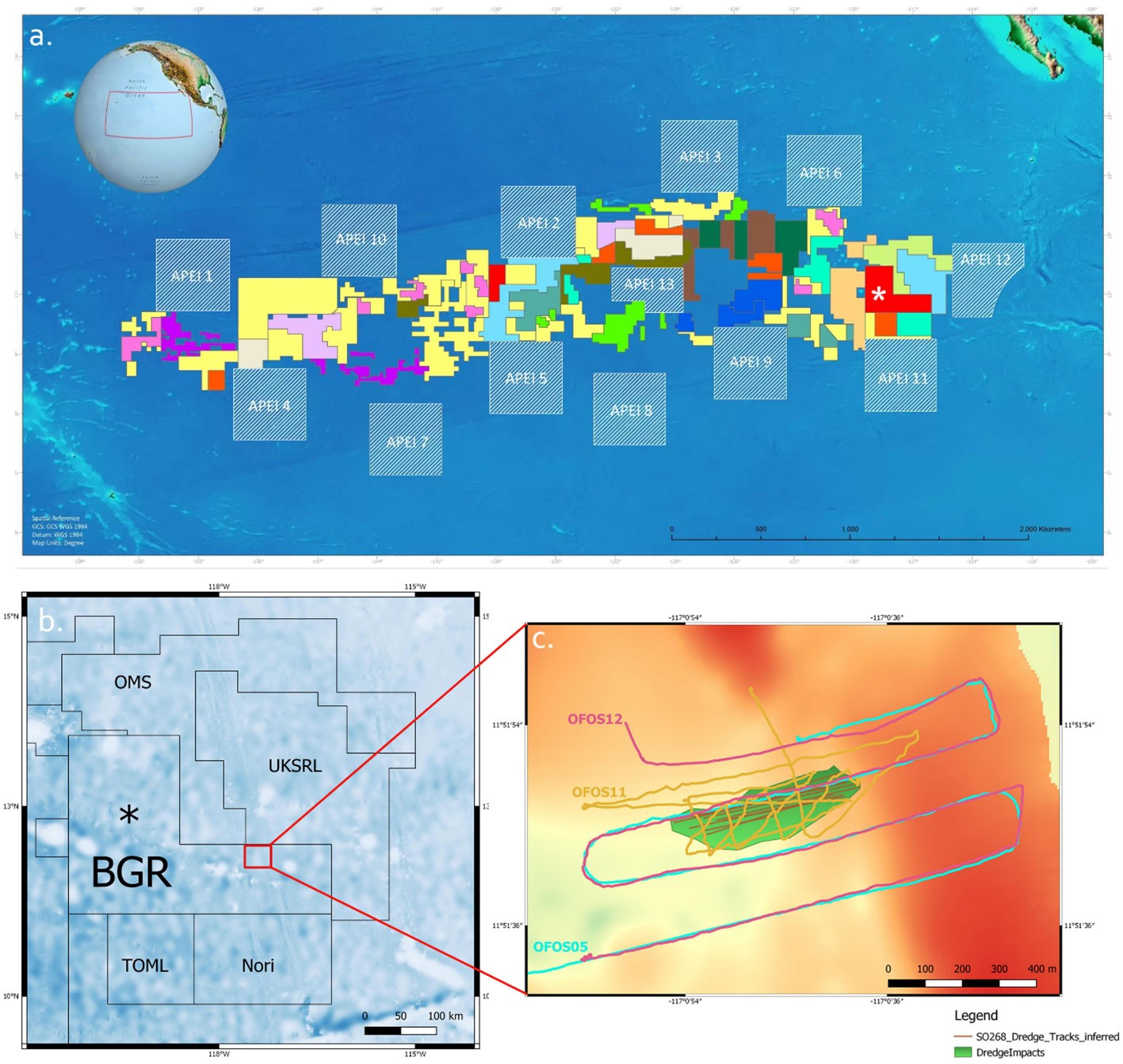The deep sea, particularly areas like the Clarion-Clipperton Fracture Zone (CCZ) in the Pacific Ocean, harbors a wealth of unique megafauna—large organisms crucial to these ecosystems. The CCZ is also rich in polymetallic nodules, mineral deposits attracting significant interest for deep-sea mining. Understanding the interplay between these mineral resources and the resident megafauna is paramount, especially given the potential environmental impacts of mining activities. Studying megafauna in such environments offers invaluable lessons in biodiversity, ecosystem function, and the potential consequences of human intervention in these fragile habitats. But accessing and analyzing the vast amounts of image data required for these studies presents significant challenges.
Figure 1: Location of the study area within the Clarion-Clipperton Fracture Zone (CCZ) and the tracks of the OFOS dives before and after the dredge disturbance experiment.
The Importance of Megafauna in the Deep Sea
Megafauna, often attached to or dependent on hard substrates like polymetallic nodules, play a vital role in the deep-sea ecosystem. They represent a significant portion of the biodiversity and contribute to essential ecological processes. Over 60% of megafauna in nodule fields rely on these nodules for survival. Studying their distribution, abundance, and behavior provides insights into the overall health and functioning of these unique environments. Baseline studies establishing megafauna diversity and abundance are crucial for understanding the potential impacts of mining and developing effective conservation strategies.
Challenges in Studying Deep-Sea Megafauna
The remote and challenging nature of the deep sea makes studying megafauna difficult. Traditional methods like physical sampling are expensive and limited in scope. Imagery collected by remotely operated vehicles (ROVs) and autonomous underwater vehicles (AUVs) has become indispensable. However, analyzing the massive datasets generated by these platforms is time-consuming and requires specialized expertise. A single AUV dive can yield hundreds of thousands of images.
Figure 2: Comparison of undisturbed (left) and dredged (right) seafloor areas, showcasing the impact of disturbance on the habitat and the automated detection of fauna by MAIA (lower panels).
Leveraging Machine Learning for Megafauna Research
To address the data analysis bottleneck, researchers are increasingly turning to machine learning tools. This study employed the Machine Learning Assisted Image Annotation (MAIA) tool within the BIIGLE system. MAIA uses deep learning algorithms to automatically detect potential megafauna in images, significantly accelerating the annotation process. This automated approach allows scientists to analyze larger datasets, gain a more comprehensive understanding of megafauna distribution, and assess the potential impacts of deep-sea mining more effectively.
Key Findings and Implications
The study found that MAIA achieved a high recall rate (over 90%) in detecting megafauna, indicating its effectiveness in identifying a large proportion of the organisms present in the images. While precision was lower, the tool still proved valuable in identifying potentially overlooked organisms and environmental features. This suggests that a hybrid approach, combining automated detection with expert validation, offers the most efficient and accurate method for analyzing large image datasets. Moreover, the research highlighted the importance of comprehensive training datasets for machine learning algorithms. The performance of MAIA improved with larger and more diverse training data, emphasizing the need for collaborative data sharing within the scientific community.
Figure 3: Diverse examples of megafauna taxa found in the BGR license area of the CCZ, illustrating the morphological variability within and between groups.
What We Can Learn: Looking Ahead
Studying megafauna in the context of deep-sea mining offers critical insights into:
- Biodiversity: Assessing the richness and distribution of megafauna helps establish baseline conditions and understand the potential loss of biodiversity due to mining.
- Ecosystem Function: Understanding the role of megafauna in nutrient cycling and habitat provision informs predictions about the broader ecosystem consequences of mining.
- Impact Assessment: Monitoring changes in megafauna populations over time allows for quantifying the direct and indirect effects of mining activities.
- Conservation Strategies: Data on megafauna distribution and habitat preferences can guide the design of protected areas and mitigation strategies.
Figure 4: Examples of correctly detected (True Positives), missed (False Negatives), and newly detected (False Positives) organisms illustrating the performance of the MAIA system. This highlights the need for expert review to validate automated results.
The integration of machine learning tools like MAIA is revolutionizing deep-sea research, allowing for more efficient and comprehensive analyses of megafauna populations. These advancements are critical for informing responsible decision-making regarding deep-sea mining and ensuring the long-term health of these valuable ecosystems. While automated tools hold immense promise, expert knowledge remains essential for validating results, refining algorithms, and translating data into meaningful ecological insights.

